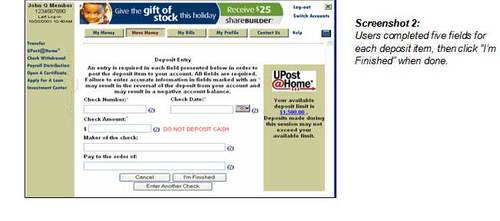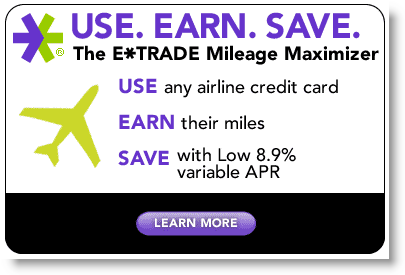Innovative Upost@home provides real-time credit for
mailed deposit items


In a remarkably simple yet highly innovative service Pennsylvania State
Employees Credit Union (Harrisburg, PA; 290,000 members; 160,000 online
users) www.psecu.com
gives qualified members immediate credit for items “deposited” online.
Users logged into online banking simply choose the Move Money tab and
follow the simple instructions. Members then have 10 days to get the deposit
to the credit union via U.S. mail before the items are backed out. There is
no fee.
To limit fraud and errors, only about 20% of the CU’s member base is
eligible for the program. These 65,000 eligible members start with $1500 in
deposit credit, but it can be increased at the discretion of the credit
union to as much as $8000 based on usage. Deposited funds are immediately
available for use and earn interest from the day of the online deposit
entry.
History
PSECU has long used a similar system for ATM deposits offering credit as
high as $20,000. The online version Upost@home, the brainchild of VP
Tom Ruback, was launched in November 2001. However, until
recently it hadn’t been publicized widely outside its member base. Four
months ago a second CU, Pentagon Federal Credit Union’s http://www.penfed.org/
launched a service modeled on PSECU’s. Pentagon Federal’s Trust In
You program has tighter limits, beginning with only $750, and increasing
to $2500 based on usage.
Results
The CU already had experience with real-time credit of ATM deposits,
suffering minimal losses across its 68,000 users (making about 180,000
deposits/month). So it was confident members would continue to be
trustworthy through a similar online system.
The online version’s volumes are lower, but are building. In December,
nearly 11,000 members made 24,000 deposits, worth $10.5 million. In the
first two years, more than 19,000 members have made deposits of $125
million, $83 million of that in 2003. More importantly for anyone thinking
of recreating the program, the service has lost only $2000 to fraud, while
saving the CU more than $100,000 in interchange.
Active users average two deposit sessions per month, with each session
containing slightly less than two items, for a total of 3.8 items per month.
At an average of $260 per item, total monthly deposits average $1000 per
active user.
Consumer Benefits
Since it’s an unusual benefit, members often need coaxing to try the
feature. PSECU sends online banking users a letter explaining the service.
Follow-ups to non-users contain a $1.37 check that can only be deposited
through the Upost service. Repeat usage is high once members
experience the benefits.
Pros
- Added convenience of simply dropping deposits in the mail; no trip
to a branch or ATM, no waiting in line
- Peace of mind knowing an image of each item will be available in
case of dispute
- Earns interest immediately
- Can immediately withdraw cash or make payments with the virtual
deposit
- A record of each deposited item is viewable within the check
register
- Preaddressed envelopes are available at no charge (NOT prepaid)
Cons
- Must order or provide envelopes and locate and pay for stamps
- Must remember to mail within a few days
- Failure to mail deposit could result in negative balance and
bounced checks
Business Case
For a credit union serving 290,000 members through two branches (10 total
teller windows) and 20 deposit-taking ATMs, the remote deposit program is a
win-win. Members like it for all the reasons mentioned above, and the CU
saves more than $0.70 per deposit compared to foreign ATM interchange fees.*
The CU can continue to minimize its bricks and mortar costs (90% of its
members have never set foot on PSECU property) while offering an innovative
benefit to online banking users.
*The CU estimates each Upost deposit cost $1.16 to process
including an “inflated” value for lost float. In comparison, it pays
about $2 for each deposit put into a non-PSECU ATM.
Table 19
Deposit Float
calendar days to receive online deposits, 2003

Source: PSECU, 1/04, deposits processed Jan through Nov 2003
How it Works
Initiating a deposit online is a simple process:
1. Within the CU’s online banking area, members then choose the
Move Money tab (screenshot 1).
2. Choose Start to initiate a new deposit
3. Member enters five fields: check number, date check written,
amount, who wrote it, who it was made out to (screenshot 2):
4. Repeat 3 for each deposit item, choose Finished
5. Write the session number in the space provided on pre-printed or
blank envelope
6. Drop the deposit into the mail
7. Deposited items are processed and images posted; the deposit line
is reset
Members receive instant credit for the deposit and can view deposit
details either through the Move Money interface, by selecting
Deposit Details, or by clicking on the deposit within their online
check register. Once the paper items have been processed, members can view
images of the deposited items.
The CU contacts the member by phone if the deposit has not been received
by the eighth day. In 2003, 81% of Upost deposits were received by
day four and more than 98% were received by day eight. Just five out of
every 1000 (0.5%) never arrived.
Table 20
PSECU Online Deposit Activity for 2003
Upost usage by PSECU
members

Source: PSECU, 1/04
Contacts
Greg Smith is CEO, [email protected]
Tom Ruback is VP Card Services,
[email protected]



 Enter E*Trade’s new Mileage Maximizer program, launched with a page-dominating color ad in Tuesday’s Wall Street Journal. With the Mileage Maximizer, the bank encourages users to make purchases on their existing non-E*Trade rewards card, then have the balances AUTOMATICALLY swept to an E*Trade 8.9% APR line of credit each month. The bank’s website is used to initiate and maintain the transfer process. But like recurring bill payments, once the sweep is established, it will occur each month with no interaction by the user.
Enter E*Trade’s new Mileage Maximizer program, launched with a page-dominating color ad in Tuesday’s Wall Street Journal. With the Mileage Maximizer, the bank encourages users to make purchases on their existing non-E*Trade rewards card, then have the balances AUTOMATICALLY swept to an E*Trade 8.9% APR line of credit each month. The bank’s website is used to initiate and maintain the transfer process. But like recurring bill payments, once the sweep is established, it will occur each month with no interaction by the user. 

 Bank of America
Bank of America









